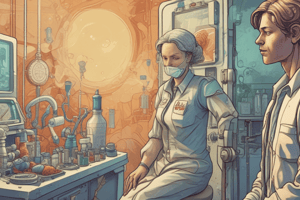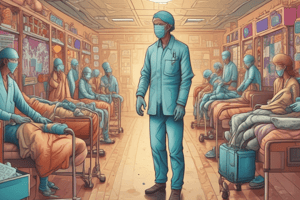Podcast
Questions and Answers
What occurs during a viral acute infection?
What occurs during a viral acute infection?
- The infection remains chronic and cannot be eliminated.
- The virus replicates indefinitely within the host.
- The virus permanently integrates into the host's DNA.
- The virus infects cells causing the disease, but is completely eliminated after recovery. (correct)
What characterizes a vaccine based on whole inactivated organisms?
What characterizes a vaccine based on whole inactivated organisms?
- It contains viruses that can replicate to provide immunity.
- It exclusively uses bacterial components to generate immunity.
- It contains a virus that cannot replicate but stimulates an immune response. (correct)
- It contains live organisms that stimulate immune response.
In a latent viral infection, which statement is true?
In a latent viral infection, which statement is true?
- The virus actively replicates in host cells.
- The virus induces host cell death.
- The viral genome is usually integrated into the host's chromosome.
- The virus does not replicate and the genome is usually in episomal form. (correct)
What is the function of the viral capsid?
What is the function of the viral capsid?
What does the glycocalyx or biofilm provide for bacteria?
What does the glycocalyx or biofilm provide for bacteria?
What is an abortive viral infection?
What is an abortive viral infection?
Which bacterium is primarily associated with community pneumonia?
Which bacterium is primarily associated with community pneumonia?
What is the biological activity of diphtheria toxin?
What is the biological activity of diphtheria toxin?
Flashcards
Viral acute infection
Viral acute infection
A virus infects cells, causing a disease, and is completely eliminated after recovery.
Inactivated virus vaccine
Inactivated virus vaccine
A vaccine containing a weakened virus that cannot replicate but stimulates the immune response.
Latent viral infection
Latent viral infection
A viral infection where the virus doesn't replicate and its genome remains non-replicating, usually in an episomal state.
Viral capsid function
Viral capsid function
Signup and view all the flashcards
Bacterial antibiotic inhibition
Bacterial antibiotic inhibition
Signup and view all the flashcards
Bacterial glycocalyx/biofilm
Bacterial glycocalyx/biofilm
Signup and view all the flashcards
Viral life cycle order
Viral life cycle order
Signup and view all the flashcards
Gram- bacteria cell wall component
Gram- bacteria cell wall component
Signup and view all the flashcards
Study Notes
Viral Acute Infections
- Viruses infect cells, causing disease
- After recovery, the virus is completely eliminated.
Vaccines
- Inactivated whole organism vaccines contain a virus that cannot replicate
- It stimulates an immune response.
Latent Infections
- Viruses replicate at a low level during latent infections.
- They replicate in lymph nodes.
- The genome is usually in an episomal form.
Viral Capsids
- Viral capsids protect the genome and mediate attachment to target cells (naked viruses).
Antibiotics
- Antibiotics treat bacterial infections, not viral.
- They inhibit bacterial replication.
Glycocalyx/Biofilm
- Allows viral adhesion.
- Aids the immune system in attacking bacteria.
- A polysaccharide structure that enhances virulence in bacteria.
Virus Envelope
- An outer layer of certain viruses.
- Made of polysaccharides or proteins.
Viral Life Cycle
- The correct order is adsorption, penetration, uncoating, replication, assembly, maturation, and release.
Staphylococcus aureus
- Causes food poisoning, toxic shock, soft tissue infections, and nosocomial infections.
Abortive Viral Infections
- Viruses enter cells but cannot complete their life cycle.
Community Pneumonia
- Streptococcus pneumoniae is the main bacterium related to community pneumonia.
Skin Rash Viruses in Children
- Varicella Zoster virus can cause skin rashes.
Lipopolysaccharides (LPS)
- Component of the cell wall of Gram-negative bacteria.
- It is toxic to humans.
- Blocks neurotransmission.
Naked Viruses
- Do not have an outer lipid envelope.
- Less sensitive to detergents and disinfectants.
- Resistant to stomach acid (allowing for intestinal infection).
Polio
- A disease causing paralysis of legs and breathing difficulties.
Bacterial Capsule
- Made of sugars.
- Prevents phagocytosis.
- Assists bacterial adhesion.
Diphtheria Toxin
- Interferes with neurotransmission.
- Increases cell permeability and fluid loss
- Disrupts protein synthesis.
Community Pneumonia Bacteria
- Streptococcus pneumoniae is the most prevalent causative agent.
Microorganisms without vaccines
- Some microorganisms, like Neisseria meningitidis group B, and Haemophilus influenzae, lack available vaccines.
Gram-positive Cell Walls
- Contain peptidoglycan, teichoic, and lipoteichoic acids.
Studying That Suits You
Use AI to generate personalized quizzes and flashcards to suit your learning preferences.




